How to conduct an effective pulse survey

Are you looking to gain valuable insights into employee sentiments, drive engagement, and enhance organizational effectiveness?
Look no further than conducting an effective pulse survey. In today's dynamic workplace, pulse surveys have emerged as a powerful tool for gathering real-time feedback from employees, allowing organizations to stay connected with their workforce and make data-driven decisions.
According to a survey, 85% of organizations consider employee engagement a top strategic priority, highlighting the significance of pulse surveys in understanding and improving employee experiences.
In this blog, we will explore the key strategies and best practices to conduct an effective pulse survey that yields meaningful results. By following these guidelines, organizations can unlock the potential of pulse surveys and harness employee insights to drive positive change.
Engaging employees and measuring their sentiments is vital in today's competitive topography.
By conducting effective employee pulse survey questions, you can gather feedback on various aspects such as employee satisfaction, organizational culture, leadership effectiveness, and workplace well-being.
However, simply administering a pulse survey is not enough. To ensure its effectiveness, organizations need to employ the right strategies throughout the survey process.
This includes crafting well-designed survey questions, ensuring confidentiality and anonymity, communicating the purpose and value of the survey to employees, analyzing the results effectively, and taking prompt action based on the feedback received.
By investing time and effort into conducting an effective pulse survey, organizations can create a feedback loop that empowers employees, drives continuous improvement, and fosters a positive work environment.
So, let's dive in and discover how to unlock the potential of pulse surveys to drive employee engagement, boost productivity, and achieve organizational success.
Table of contents:
- What is the primary goal of the quick pulse survey?
- Purpose of a pulse survey
- Common uses of employee pulse surveys
- What makes pulse surveys so effective?
- What makes a good pulse survey?
- What questions should a pulse survey include?
- Integrating pulse surveys seamlessly into your engagement strategy
- How many questions should be in a pulse survey?
- What does an ideal pulse survey frequency look like?
- Why communicating the purpose of a pulse survey is important?
- Will pulse surveys replace annual engagement surveys?
- What is a good participation rate for a pulse survey?
- How can I improve my pulse survey results?
- Overcoming common challenges in pulse surveys
- How to plan the launch of your employee pulse surveys?
- Preparing for future trends in pulse surveys for HR leaders
- How to launch your pulse survey with CultureMonkey?
What is the primary goal of the quick pulse survey?
The primary goal of a quick pulse survey is to gather immediate feedback from employees on specific topics or issues promptly.
Unlike traditional employee surveys that are more comprehensive and conducted on an annual or biannual basis, quick pulse surveys focus on obtaining real-time insights to address immediate concerns, monitor changes in employee sentiment, and guide timely decision-making.
The main objective of a quick pulse survey is to capture a snapshot of employee opinions, attitudes, and experiences efficiently and effectively. These surveys typically have a shorter length, containing a limited number of targeted questions that are concise and focused.
By leveraging pulse surveys, organizations can swiftly identify emerging trends, areas of improvement, and potential challenges within their workforce.
The quick pulse survey enables organizations to react promptly to employee feedback, helping them make informed decisions and implement necessary actions on time.
This agile approach to gathering feedback allows organizations to stay responsive to the dynamic needs and expectations of their employees.
By regularly conducting quick pulse surveys, organizations can foster a culture of continuous improvement, enhance employee engagement, and address concerns before they escalate.
The primary goal is to create an open feedback loop that empowers employees to share their opinions and enables organizations to adapt and thrive based on the insights gained.
It's important to note that the specific goals of a quick pulse survey may vary depending on the organization's objectives.
Some common objectives include measuring employee satisfaction, monitoring changes in engagement levels, assessing the effectiveness of organizational initiatives, and identifying areas for improvement in a targeted and timely manner.
Purpose of a pulse survey
A pulse survey is not just a questionnaire; it's a strategic compass, providing real-time insights into the heartbeat of your workforce. Picture this: a quick, targeted set of questions that enable you to gauge employee sentiment, identify areas of concern, and uncover untapped potential.
It's a diagnostic checkup for your organizational health, allowing you to detect issues before they escalate, and seize opportunities before they slip away.
The purpose of a pulse survey is two-fold. Firstly, it fosters a culture of open communication, giving every employee a voice in the organizational dialogue. Secondly, it equips leadership with actionable data, transforming subjective impressions into objective metrics.
By regularly pulsing your organization, you not only demonstrate a commitment to employee well-being but also empower your team to actively shape the future of your company.
In essence, a pulse survey is more than a tool; it's a testament to your dedication to organizational excellence. It's the heartbeat of a thriving workplace, where communication flows freely, and insights drive informed decision-making.
Common uses of employee pulse surveys
Employee pulse surveys are versatile tools that provide targeted insights to enhance engagement and drive organizational success. Here are their common uses:
- Monitoring employee engagement: Track engagement levels with short, frequent surveys that focus on key drivers like autonomy, career growth, and alignment with company goals.
- Assessing workplace culture: Measure how well employees align with organizational values to ensure these are being "lived" across the company.
- Measuring leadership effectiveness: Gather feedback on leadership performance, including communication, transparency, and support, to guide development.
- Evaluating new initiatives: Gauge employee sentiment during changes like restructuring or policy updates to address concerns and refine strategies.
- Addressing well-being concerns: Monitor stress levels, mental health, and workload balance to proactively support employee well-being.
- Action planning follow-up: Track the progress of post-survey action plans with regular feedback to ensure continuous improvement.
What makes pulse surveys so effective?
Pulse surveys stand out due to their ability to provide real-time, actionable insights. Unlike traditional, lengthy surveys, pulse surveys focus on concise, targeted questions that address specific topics. This design ensures organizations can quickly gauge employee sentiment, spot trends, and respond to emerging issues without delay.
The timeliness of feedback creates a more responsive and adaptive work environment, allowing companies to pivot strategies and implement improvements swiftly. Furthermore, pulse surveys foster a culture of continuous engagement by maintaining regular touchpoints with employees.
This regular cadence shows employees that their opinions matter and are valued by the organization. It builds trust and promotes a sense of inclusion in decision-making processes.The flexible and scalable nature of pulse surveys also enhances their effectiveness.
They can be tailored to the unique needs of departments, teams, or entire organizations, ensuring the feedback collected is relevant and impactful. By leveraging this adaptable approach, organizations can boost participation, gain valuable insights, and drive meaningful change.
What makes a good pulse survey?
A well-designed pulse survey possesses several key attributes that make it effective in capturing valuable employee feedback.
Here are the characteristics that contribute to a good pulse survey:
Relevance and focus
A good pulse survey is targeted and focused on specific areas of interest or organizational goals. It includes questions that directly address the topics or issues that organizations seek to understand or improve.
Keeping the survey focused, ensures that the collected feedback is meaningful and actionable.
Conciseness and clarity
A pulse survey should be concise and easy to understand. It avoids complex language or jargon, uses clear and straightforward questions, and keeps the survey length manageable.
Conciseness helps minimize respondent fatigue and increases the likelihood of higher participation rates.
Valid and reliable measures
A good pulse survey utilizes valid and reliable measures to assess employee sentiments accurately. It employs established scales, such as Likert scales, that have been rigorously tested and proven to measure attitudes and perceptions effectively. This ensures the survey produces reliable and comparable results.
A mix of question types
A good pulse survey includes a mix of question types to capture both quantitative and qualitative data. It combines closed-ended questions (e.g., multiple-choice, rating scales) for quantitative analysis and open-ended questions for qualitative insights.
This combination provides a more comprehensive understanding of employee experiences and opinions.
Anonymity and confidentiality
A good pulse survey ensures the anonymity and confidentiality of respondent data. Employees should feel comfortable sharing their honest feedback without fear of identification.
Assurances of data privacy build trust and encourage participation, leading to more candid and reliable responses.
Regular frequency
A good pulse survey is conducted at regular intervals to capture timely feedback and monitor changes over time. The frequency depends on the organization's needs but is often monthly or quarterly.
Regular surveys enable organizations to track trends, identify emerging issues, and evaluate the impact of interventions.
Actionable Insights
A good pulse survey is designed to yield actionable insights. It includes questions that provide meaningful data to guide decision-making and intervention strategies.
The survey results should prompt organizations to take specific actions based on the feedback received, leading to improvements in employee engagement and satisfaction.
Communication and follow-up
A good pulse survey incorporates clear communication plans to inform employees about the purpose, process, and outcomes of the survey.
Organizations should communicate survey results and actions taken in response to employee feedback.
This demonstrates a commitment to transparency and reinforces the value of employee participation.
Ease of accessibility
A good pulse survey ensures ease of accessibility for all participants. It should be designed with a user-friendly interface that accommodates various devices and accessibility needs.
This inclusivity promotes broader participation across diverse employee groups, fostering a more representative and insightful feedback collection.
Strategic alignment
A good pulse survey is strategically aligned with the organization's overarching goals and values. The survey questions should directly link to key performance indicators (KPIs) and align with the company's mission and vision.
This alignment ensures that the survey outcomes contribute meaningfully to the organization's strategic decision-making processes.
Flexibility and adaptability
A good pulse survey demonstrates flexibility by allowing for adaptations based on changing organizational priorities. It should be dynamic enough to incorporate new topics or concerns that may arise over time. This adaptability ensures that the survey remains relevant and continues to address evolving organizational needs.
Benchmarking capability
A good pulse survey includes elements that facilitate benchmarking against industry standards or internal benchmarks. Comparative data allows organizations to assess their performance relative to peers or past performance.
Benchmarking enhances the interpretation of survey results and provides context for understanding where improvements are needed.
Employee involvement in survey design
A good pulse survey involves employees in its design process. Including employees in the creation of survey questions fosters a sense of ownership and relevance.
This participation ensures that the survey truly reflects the concerns and priorities of the workforce, making the feedback collected more authentic and valuable.
By adhering to these characteristics, organizations can create pulse surveys that effectively capture employee feedback, drive meaningful change, and foster a culture of continuous improvement.
It is essential to tailor the engagement survey design to the specific needs and objectives of the organization while considering industry best practices and employee engagement principles.
What questions should a pulse survey include?
The effectiveness of a pulse survey lies in asking targeted questions that align with organizational goals and address employee needs. Questions should be concise, relevant, and focused on key areas of interest. Here are examples of common question categories to include:
Engagement questions
- Example: "Do you feel motivated to perform your best at work?"
These questions assess employee engagement levels, helping organizations understand how connected employees feel to their work and the company.
Well-being questions
- Example: "How would you rate your current work-life balance?"
Well-being questions provide insights into employee mental health and stress levels, enabling organizations to take proactive measures to support their teams.
Leadership questions
- Example: "Does your manager provide the support you need to succeed?"
Leadership-focused questions evaluate how effectively managers and leaders support their employees, helping identify areas for improvement.
Cultural alignment questions
- Example: "Do you feel that the company’s values are reflected in your daily work?"
These questions ensure that employees perceive a strong alignment between organizational values and workplace practices.
Change management questions
- Example: "Do you feel informed and supported during recent organizational changes?"
Targeted at employees undergoing transitions, these questions help gauge the success of change initiatives.
Tailoring Questions for Impact
To ensure meaningful feedback, customize your pulse survey questions to reflect organizational priorities and current challenges. For instance, during times of change, focus on adaptability and support. For DEI initiatives, include questions about inclusivity and belonging. Tailoring questions ensures you address what matters most to your employees and your organization.
By using targeted and well-crafted questions, pulse surveys can provide actionable insights that drive positive organizational change.
Integrating pulse surveys seamlessly into your engagement strategy
Pulse surveys are an essential part of a comprehensive feedback strategy, complementing other mechanisms like annual engagement surveys. While annual surveys provide a deep, holistic view of organizational health, pulse surveys offer timely, focused insights to address immediate concerns and track progress over time.
- Complementing annual engagement surveys: An annual engagement survey is ideal for understanding long-term trends and establishing benchmarks, but they often lack the immediacy to capture real-time feedback. Pulse surveys fill this gap by providing short, frequent touchpoints that keep the organization connected to employees’ evolving sentiments. Together, these tools create a balanced approach to employee feedback.
- Creating a continuous feedback loop: Pulse surveys enable organizations to maintain an ongoing dialogue with employees. By gathering real-time insights at regular intervals, they help monitor the impact of actions taken after annual surveys and adjust strategies as needed. This continuous loop fosters transparency and reinforces a culture of listening and improvement.
Actionable steps to incorporate pulse surveys
- Define objectives: Identify the specific goals of your pulse surveys, such as tracking progress on engagement drivers or measuring the success of new initiatives.
- Integrate into key milestones: Use pulse surveys during onboarding to gauge early impressions or after exit interviews to identify trends in turnover.
- Schedule strategically: Plan pulse surveys in alignment with your annual survey cadence to avoid survey fatigue while ensuring timely insights.
- Analyze and act: Share results promptly and connect them to actionable steps, ensuring employees see how their feedback drives change.
How many questions should be in a pulse survey?
The ideal number of questions in a pulse survey depends on various factors, including the survey's purpose, the target audience, and the time available for respondents to complete it.
While there is no fixed rule, it is generally recommended to keep pulse surveys concise and focused to maximize participation rates and obtain accurate responses.
A pulse survey typically consists of 10-15 questions, although some organizations prefer even shorter surveys with around 5-10 questions. This length ensures that the survey can be completed within a reasonable time frame, reducing respondent burden and increasing engagement.
Research suggests that shorter surveys have higher completion, higher response rates, and result in more reliable data.
When determining the number of questions, it is crucial to prioritize the most critical areas of inquiry aligned with the survey's goals. This ensures that the survey remains focused on obtaining specific insights and actionable feedback.
Including too many questions can lead to respondent fatigue, decreased attention, and potentially lower data quality.
To keep the survey concise, consider using questionnaires that utilize skip logic or branching. This approach tailors the survey experience by displaying questions relevant to respondents based on their previous responses.
Streamlining the survey flow reduces redundancy and improves the overall user experience.
Additionally, consider the frequency of pulse surveys. If conducted frequently (e.g., monthly or quarterly), it may be more practical to have a smaller number of questions in each survey to avoid survey fatigue.
On the other hand, if the pulse survey is conducted less frequently (e.g., annually), organizations may opt for a slightly longer survey to capture a broader range of insights.
Ultimately, the key is to strike a balance between gathering sufficient data and respecting respondents' time and attention.
By keeping pulse surveys concise, focused, and relevant, organizations can increase response rates, collect valuable feedback, and facilitate effective decision-making based on the obtained insights.
What does an ideal pulse survey frequency look like?
The ideal pulse survey frequency varies depending on the organization's needs and goals. While there is no one-size-fits-all approach, many organizations find success with monthly or quarterly pulse surveys.
These intervals allow for regular check-ins and provide timely feedback to track changes in employee sentiment.
It is important to strike a balance between survey frequency and survey fatigue, ensuring that employees have enough time to process and respond to the surveys effectively.
Flexibility in survey frequency allows organizations to adapt based on their specific context and resources while maintaining a consistent feedback loop with employees.
Why communicating the purpose of a pulse survey is important?
Communicating the purpose of a pulse survey is essential for several reasons. Firstly, it helps employees understand the significance of their participation and encourages their engagement.
By clearly articulating the purpose, organizations can convey their commitment to listening to employee feedback and driving positive change.
Secondly, communicating the purpose builds trust and transparency. When employees understand why the survey is being conducted, how the data will be used, and the potential impact on decision-making, they are more likely to provide honest and thoughtful responses.
This fosters a culture of open communication and shows that their input is valued.
Furthermore, communicating the purpose manages expectations. Employees may wonder about the confidentiality of their responses or the actions that will be taken based on the survey results.
By addressing these concerns upfront, organizations can alleviate any uncertainties and ensure that employees feel comfortable sharing their feedback.
Lastly, communicating the purpose allows employees to align their responses with the objectives of the survey. When employees understand what aspects of their work experiences or organizational environment are being assessed, they can provide more relevant and focused feedback.
This leads to more actionable insights and enhances the usefulness of the survey data.
Overall, effective communication of the purpose of a pulse survey establishes a foundation of trust, encourages employee engagement, manages expectations, and helps employees provide meaningful feedback.
It enables organizations to gather accurate data, make informed decisions, and drive improvements in employee engagement and organizational performance.
Will pulse surveys replace annual engagement surveys?
The role of pulse surveys in the realm of employee engagement is not necessarily to replace annual engagement surveys, but rather to complement them.
While annual employee engagement surveys provide a comprehensive view of employee sentiment and organizational health, pulse surveys offer a more frequent and agile approach to gathering employee feedback.
Pulse surveys provide timely insights into the evolving needs and experiences of employees, allowing organizations to identify and address emerging issues quickly. They enable regular check-ins, monitor changes in employee sentiment, and provide an opportunity for timely interventions.
On the other hand, annual employee engagement surveys can provide a broader and more in-depth analysis of employee engagement levels, helping organizations identify long-term trends and patterns.
Both pulse surveys and annual engagement surveys serve unique purposes in the employee feedback landscape. Annual surveys provide a comprehensive understanding of the overall employee experience and serve as a benchmark for tracking progress over time.
They allow organizations to dive deep into various aspects of engagement, from company culture, to leadership, and organizational effectiveness.
Pulse surveys, on the other hand, focus on specific areas or targeted topics. They capture immediate feedback, measure the impact of specific interventions, and help organizations make timely adjustments.
Pulse surveys excel at providing real-time insights that can be used to address urgent issues or assess the effectiveness of recent changes.
Combining the strengths of pulse surveys and annual engagement surveys can yield a more holistic and actionable view of employee engagement.
Organizations can leverage annual surveys for long-term planning and strategy while using pulse surveys to complement them with regular check-ins and targeted interventions.
Ultimately, the choice to use pulse surveys, annual engagement surveys, or a combination of both depends on the organization's specific needs, resources, and goals.
The key is to design a feedback strategy that aligns with the organizational culture, supports continuous improvement, and fosters a culture of engagement and open communication with employees.
What is a good participation rate for a pulse survey?
Determining the optimal participation rate for a pulse survey is a nuanced endeavor that hinges on various factors, including organizational culture, survey frequency, and industry dynamics. While there isn't a one-size-fits-all benchmark, a participation rate of 70-80% is generally considered a robust indicator of survey efficacy.
This range ensures a substantial representation of the workforce, fostering a comprehensive understanding of employee sentiment.
In industries with traditionally high engagement, such as technology or healthcare, achieving participation rates at the upper end of the spectrum is not uncommon. For instance, a leading tech company might consistently attain an 80% participation rate, indicative of a workforce deeply invested in the organizational discourse.
This heightened engagement often correlates with a culture that values open communication and proactive employee involvement.
Conversely, industries characterized by a dispersed or remote workforce may experience slightly lower participation rates. In fields like consulting or financial services, where professionals often work autonomously or remotely, a participation rate of 70-75% can still be indicative of a healthy level of engagement.
It's crucial to note that the goal is not merely to achieve a high participation rate for its own sake but to ensure a representative sample that genuinely reflects the diverse perspectives within the organization.
How can I improve my pulse survey results?
Improving the efficacy of your pulse survey results requires a thoughtful approach that extends beyond the mere administration of questionnaires. Here are strategic pointers to enhance the impact of your pulse survey and garner more insightful responses:
- Transparent communication: Clearly communicate the purpose and goals of the pulse survey to your employees. Transparency fosters trust and encourages genuine participation.
- Survey design: Craft concise and targeted questions that align with the survey's objectives. Avoid ambiguity to ensure respondents provide accurate and meaningful feedback.
- Frequency matters: Strike a balance in survey frequency. Too infrequent, and you risk missing critical developments; too frequent, and you may encounter survey fatigue. Align the frequency with your organization's dynamics.
- Anonymity assurance: Emphasize the anonymity of responses. When employees feel secure in providing honest feedback without fear of repercussions, you're more likely to capture candid insights.
- Actionable feedback loop: Establish a clear mechanism for acting on survey findings. Communicate how the collected feedback will be used to drive positive change, demonstrating a commitment to continuous improvement.
- Leadership engagement: Encourage leadership participation in the survey and subsequent initiatives. When leaders actively engage with the process, it reinforces the significance of employee feedback and sets the tone for a collaborative organizational culture.
- Customization for departments: Tailor survey questions to specific departments or teams when applicable. This ensures that the survey resonates with the unique challenges and dynamics of different segments within the organization.
- Training on survey participation: Provide training or resources on effective survey participation. Educate employees on the importance of their input and how it contributes to the organization's overall growth and well-being.
- Timely feedback loop: Establish a prompt feedback loop. Communicate survey results and the ensuing action plan in a timely manner. This not only demonstrates responsiveness but also reinforces the value placed on employee input.
- Continuous evolution: Regularly review and refine your pulse survey strategy. As your organization evolves, so should your approach to capturing employee sentiment. Stay attuned to changing dynamics to ensure the ongoing relevance and effectiveness of your surveys.
Overcoming common challenges in pulse surveys
1. Survey fatigue
Frequent surveys can overwhelm employees, leading to lower response rates and disengagement. To combat survey fatigue:
- Be strategic with timing: Space surveys out to avoid overlap with busy periods or other organizational events. Monthly or quarterly surveys are often effective.
- Limit the scope: Keep pulse surveys concise, focusing on 5-10 targeted questions to minimize the time required to complete them.
- Demonstrate impact: Share results and highlight actions taken based on feedback. Employees are more likely to engage if they see tangible outcomes.
2. Confidentiality concerns
Employees may hesitate to provide honest feedback if they fear being identified. To address these concerns:
- Reinforce anonymity: Use survey tools that guarantee responses are confidential and communicate this clearly.
- Limit access to raw data: Provide aggregated results to managers instead of individual responses to protect identities.
- Foster a culture of trust: Normalize open communication and show employees that feedback is valued and used constructively.
3. Leadership buy-in
Without leadership involvement, pulse surveys may fail to drive meaningful change. To secure buy-in:
- Highlight the ROI: Present data showing how pulse surveys improve engagement and reduce turnover.
- Involve leaders early: Engage leadership in survey planning, ensuring alignment with organizational goals.
- Share tailored insights: Provide actionable insights specific to departments or teams, making the data more relevant and valuable to leaders.
4. Low participation rates
Low participation can skew survey results and reduce their reliability. To increase response rates:
- Communicate the purpose: Explain how feedback will influence organizational decisions and improvements.
- Use multiple channels: Leverage emails, Slack, WhatsApp, and intranet announcements to reach employees effectively.
- Send reminders strategically: Use automated reminders with positive messaging, focusing on the value of participation.
How to plan the launch of your employee pulse surveys?
Launching employee pulse surveys requires meticulous planning to ensure maximum participation and meaningful insights. Here's a step-by-step guide to orchestrating a successful launch:
- Select the right frequency: Determine the survey frequency based on your organizational dynamics. Consider factors such as industry norms, the pace of change within your company, and the time required for actionable follow-ups.
- Build a communication plan: Develop a comprehensive communication strategy. Announce the upcoming survey well in advance, emphasizing its importance and the role employees play in shaping the organization's future. Leverage various channels like emails, town hall meetings, and intranet announcements.
- Ensure anonymity and confidentiality: Communicate the anonymity and confidentiality of responses. Reassure employees that their feedback is crucial, and measures are in place to protect their privacy. This assurance fosters trust and encourages candid responses.
- Craft engaging survey questions: Invest time in designing clear, concise, and relevant survey questions. Ensure that each question aligns with the overall objectives and contributes to gathering actionable insights.
- Test the survey: Prior to launch, conduct a pilot or test the survey with a small group of employees. This not only ensures the technical functionality of the survey platform but also provides insights into how well the questions resonate with your workforce.
- Select an appropriate survey tool: Choose a user-friendly and reliable survey tool. Consider features such as anonymity settings, ease of response, and analytical capabilities. The right tool streamlines the process and enhances the overall survey experience.
- Launch and monitor: Launch the survey on the scheduled date. Monitor response rates in real-time and send periodic reminders to encourage participation. Address any technical issues promptly to minimize disruptions.
- Provide regular updates: Keep employees informed about survey progress. Share updates on response rates and express appreciation for their participation. This ongoing communication reinforces the significance of their input.
- Close the survey and analyze results: Set a clear deadline for survey completion and promptly close it as scheduled. Begin the analysis phase, examining the results against predefined benchmarks and identifying key themes and trends.
- Feedback and action plan: Share survey findings with the workforce, highlighting key takeaways and outlining the action plan. Clearly communicate how the organization intends to address identified issues and leverage positive feedback.
Preparing for future trends in pulse surveys for HR leaders
The landscape of employee feedback is evolving rapidly, with pulse surveys at the forefront of innovation. HR leaders must stay ahead by embracing emerging trends that enhance data collection, analysis, and actionable insights. Here are key future trends shaping pulse surveys and how they can revolutionize organizational engagement:
AI-driven analytics
Artificial intelligence is transforming how feedback is analyzed. Predictive analytics tools can identify patterns in employee responses, flagging early signs of disengagement or burnout.
- How it helps: HR leaders can take targeted actions before issues escalate, improving retention and morale.
- Example: AI can correlate survey results with turnover data, predicting which teams may require additional support.
Conversational surveys
Conversational surveys mimic natural interactions, making the feedback process feel less formal and more engaging. These tools often use chatbot interfaces to gather real-time input.
- How it helps: Employees are more likely to provide honest and thoughtful feedback in a conversational format.
- Example: Chat-like surveys embedded in messaging apps like Slack or WhatsApp can increase participation rates significantly.
Integration with people analytics platforms
Integrating pulse survey data with comprehensive people analytics platforms allows HR leaders to connect survey insights with broader organizational metrics.
- How it helps: This integration provides a holistic view of workforce health, linking engagement data with KPIs like productivity, retention, and revenue.
- Example: Combining pulse survey results with absenteeism data can reveal deeper insights into workplace trends.
Diversity, Equity, and Inclusion (DEI) insights
Pulse surveys tailored for DEI initiatives can track employees’ sense of belonging, fairness, and inclusivity. These insights help organizations identify areas for improvement in workplace diversity.
- How it helps: Regular DEI-focused surveys ensure accountability and guide impactful interventions.
- Example: Questions assessing inclusivity in decision-making processes can uncover disparities across demographics.
Real-time sentiment tracking
Advancements in sentiment tracking tools now allow organizations to gather ongoing feedback without formal surveys. These tools analyze employee sentiment through various touchpoints, such as internal communications or informal check-ins.
- How it helps: Continuous sentiment tracking provides HR leaders with up-to-date insights, enabling swift adjustments to policies or practices.
- Example: Real-time feedback tools can highlight dips in morale during periods of organizational change.
How to launch your pulse survey with CultureMonkey?
Launching your pulse survey with CultureMonkey is a straightforward and efficient process. Here are the steps to successfully launch your pulse survey:
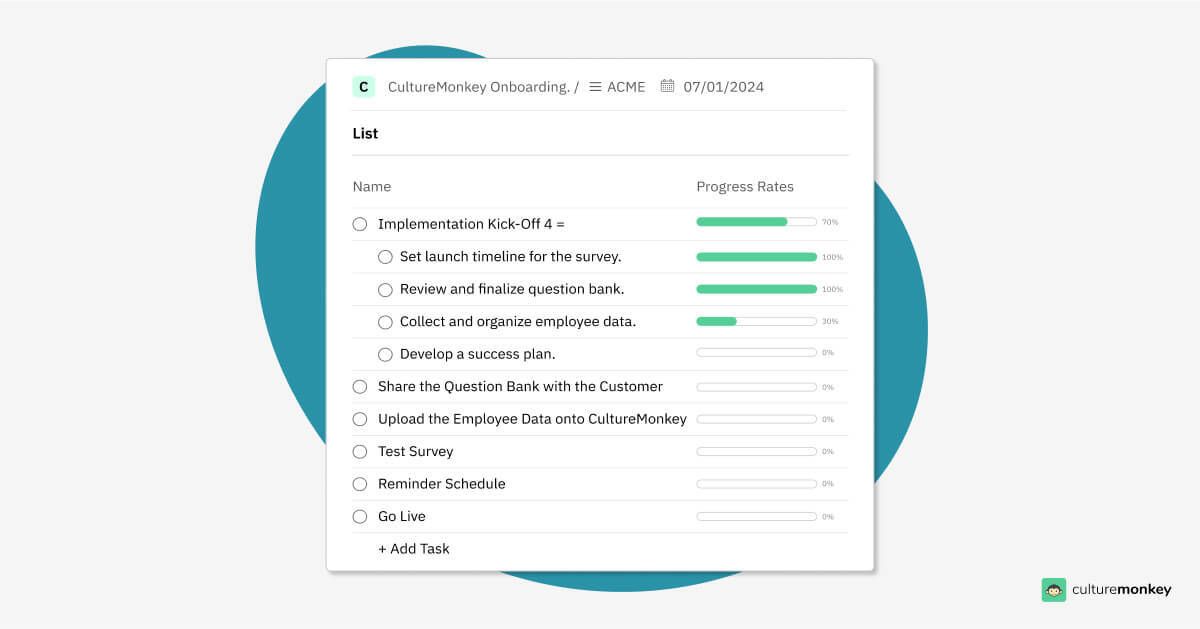
Define your survey objectives
Clearly outline the purpose, goals and timeline of your pulse survey. Identify the key areas of inquiry and the specific insights you hope to gain from the survey.
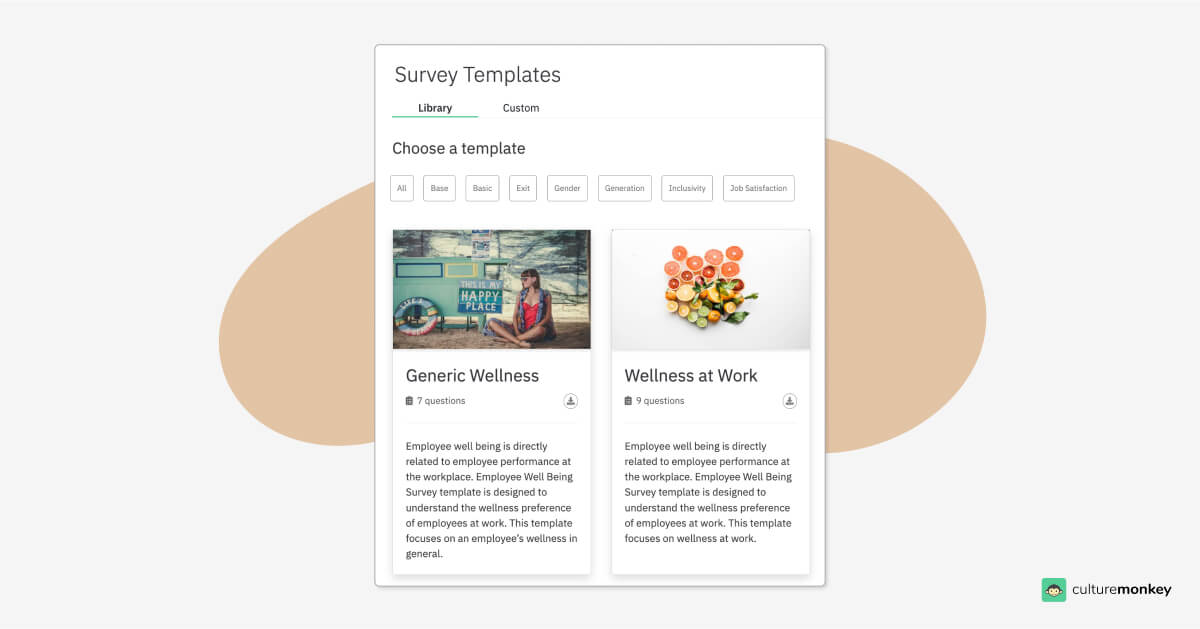
Customize your survey
Use the CultureMonkey’s pulse survey tool to customize your pulse survey to align with your organization's needs. Choose from a variety of question types, including multiple-choice, rating scales, and open-ended questions. Tailor the pulse survey questions to address the specific topics or issues you want to explore.
Determine the survey frequency
Decide how often you want to conduct your pulse survey. CultureMonkey allows for flexibility in survey frequency, whether you choose to run it monthly, quarterly, or at other intervals that suit your organization's needs.
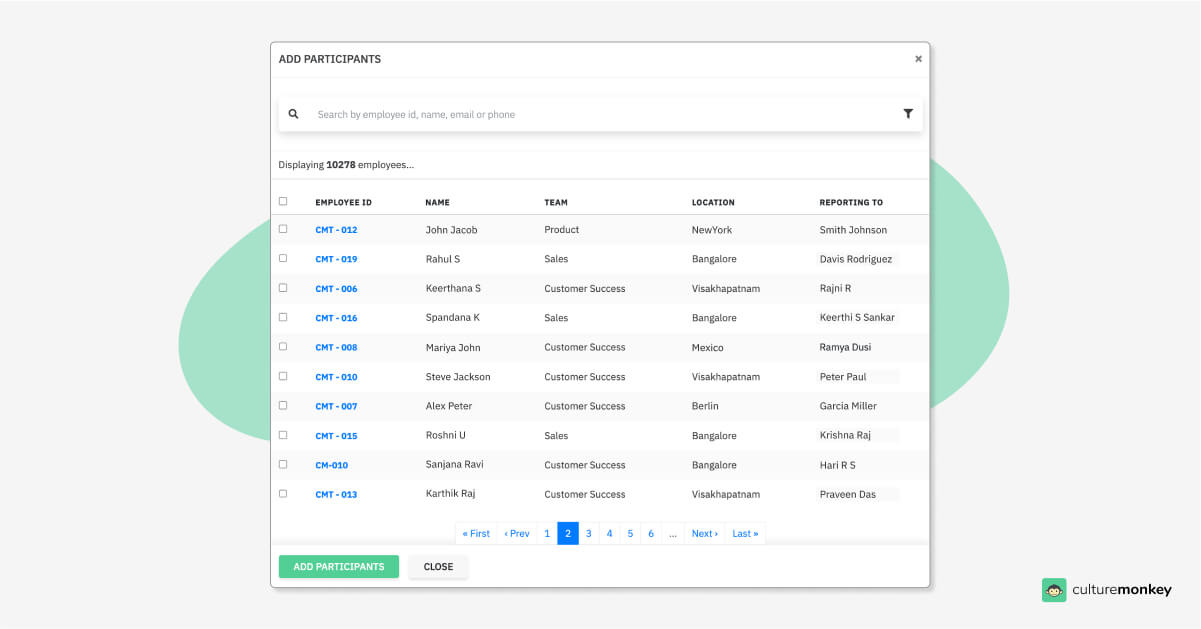
Designate survey participants
Select the employees who will participate in the pulse survey. CultureMonkey enables you to target specific departments, teams, or the entire organization, depending on your requirements.
Launch the survey
When you're ready to launch your pulse survey, simply click the "Launch" button on the CultureMonkey platform. This will send out the survey invitations to the designated participants via email.
Monitor survey progress
Use the real-time analytics and reporting features of CultureMonkey to track the progress of your pulse survey. Monitor response rates, completion rates, and other key metrics to ensure the staff pulse survey has a sufficient level of participation.
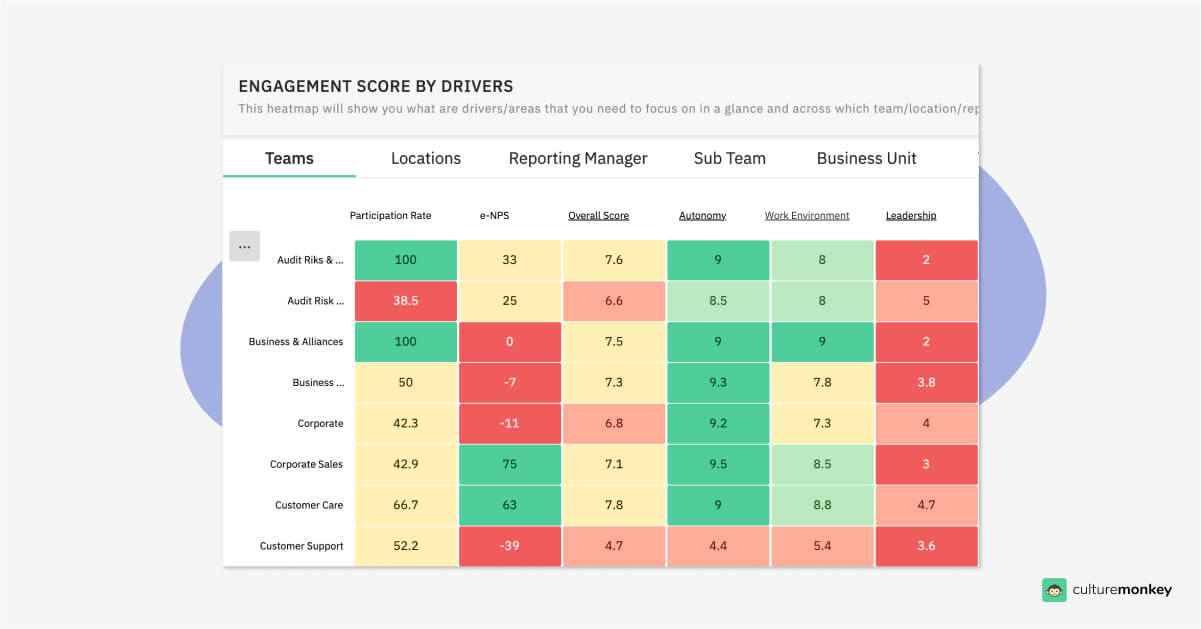
Analyze the survey results
Once the survey is completed, CultureMonkey provides comprehensive data analysis tools to help you make sense of the survey results. Explore the quantitative and qualitative feedback to gain valuable insights into employee sentiments and identify areas for improvement.
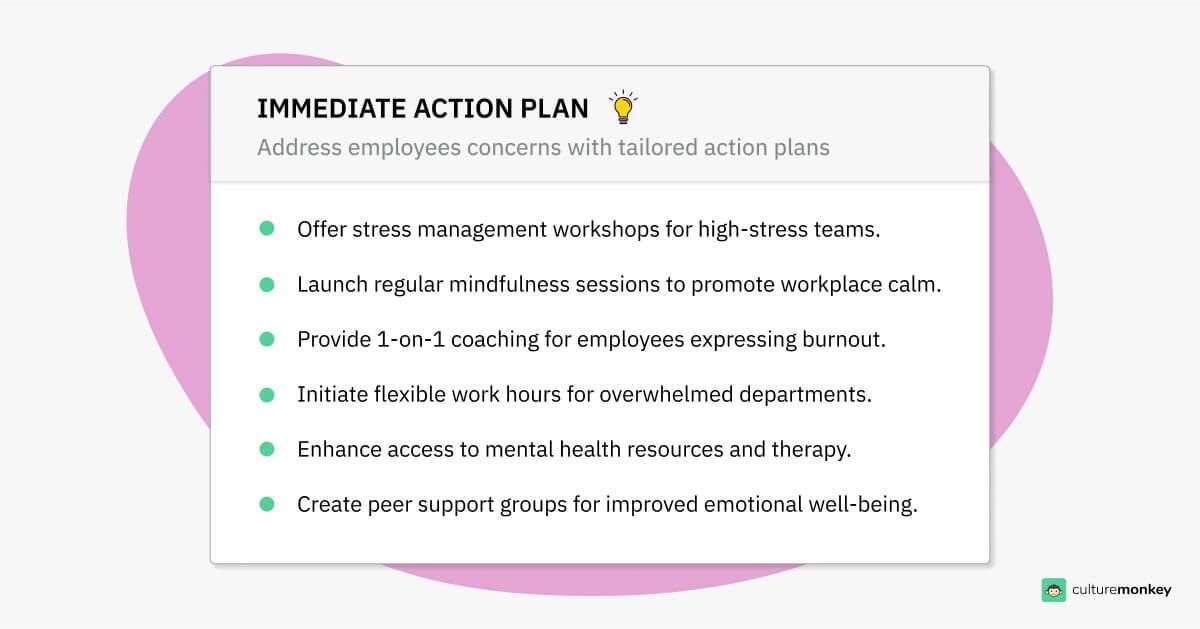
Take action based on insights
Leverage the insights obtained from the pulse survey to drive meaningful change within your organization. Use the data to inform decision-making, develop action plans, and implement interventions that address the feedback received.
Communicate the survey outcomes
Share the survey results and any actions taken in response with your employees. Cultivate a culture of transparency by communicating how their feedback has influenced organizational decisions and improvements.
Launching your pulse survey with CultureMonkey empowers you to gather valuable employee feedback, monitor engagement levels, and drive positive change within your organization.
The platform streamlines the survey process, facilitates data analysis, and provides the tools you need to enhance employee engagement and foster a thriving workplace culture.
Conducting an effective pulse survey requires careful planning, thoughtful design, and proactive action. By following best practices such as defining clear objectives, selecting appropriate survey questions, ensuring anonymity, and communicating the purpose, organizations can gather valuable feedback from employees.
The survey results should be analyzed promptly, and actions should be taken to address identified issues and capitalize on strengths.
Regular pulse surveys, combined with open communication and a commitment to continuous improvement, foster a culture of employee engagement and contribute to the overall success of the organization.
Conducting effective pulse surveys enables organizations to stay connected with their employees, drive positive change, and create a thriving work environment.
FAQs
1. What are the top mistakes to avoid in pulse surveys?
Avoid unclear survey goals, overly frequent surveys causing fatigue, poorly designed questions lacking focus, and failure to ensure anonymity. Not acting on feedback erodes trust, while long surveys reduce participation. Focus on concise, relevant questions, communicate purpose clearly, and show employees how their feedback leads to meaningful organizational improvements.
2. What triggers a quick pulse survey?
Quick pulse surveys are triggered by events needing immediate feedback, such as organizational changes, new initiatives, or rising engagement concerns. They’re also used to monitor action plans, post-annual surveys or to address pressing issues like well-being during crises. Quick surveys provide real-time insights to guide timely and informed decision-making.
3. What is a pulse score?
Pulse score measures overall employee sentiment based on pulse survey responses. It aggregates key metrics like engagement, satisfaction, or alignment with values, offering a snapshot of organizational health. Monitoring pulse scores over time helps HR leaders identify trends, address concerns proactively, and measure the impact of engagement strategies.
4. What are the 6 main types of survey questions?
The six main types of survey questions are multiple-choice, rating scales, Likert scales, open-ended, ranking, and demographic. Each type serves a purpose—rating scales quantify sentiment, open-ended questions capture deeper insights, and demographic questions segment responses. Using a mix ensures comprehensive, actionable insights into employee experiences and engagement.
5. Can pulse surveys be customized for specific goals?
Yes, pulse surveys can be tailored to align with specific goals like monitoring engagement, tracking DEI initiatives, or measuring leadership effectiveness. Customize questions to address organizational priorities and departmental needs. This targeted approach ensures relevant, actionable insights, allowing HR leaders to design interventions that directly impact desired outcomes.
